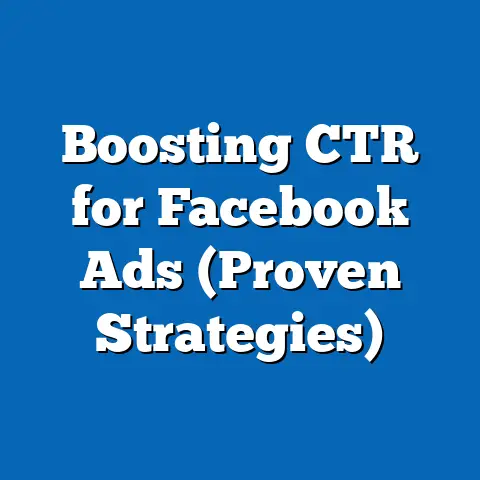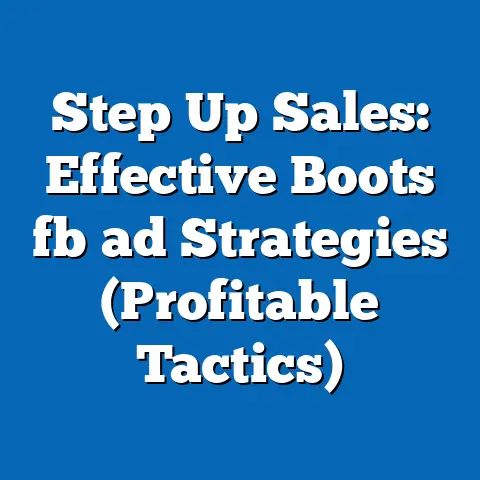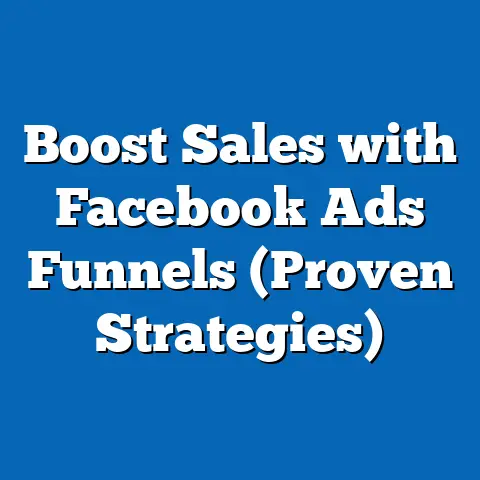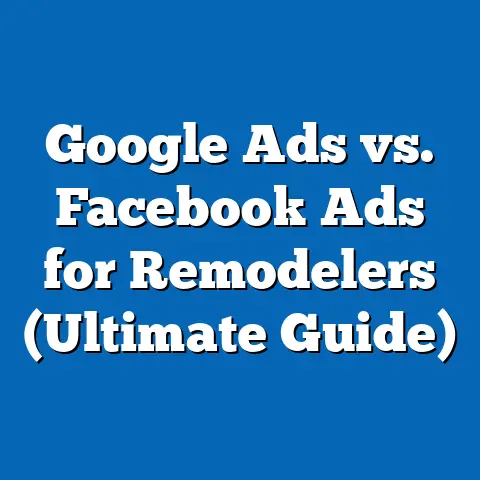Transforming Facebook Ad Costs in North Miami (Pro Strategies)
What’s your favorite taste in the world of advertising – sweet success or bitter failure? Just like a perfectly balanced dish, a well-executed advertising strategy leaves a satisfying taste, while a poorly planned campaign can leave a sour taste in your mouth. In North Miami, a vibrant hub of diverse businesses and a growing digital landscape, mastering your Facebook ad spend is crucial. I’ve seen firsthand how local businesses struggle to cut through the noise and optimize their budgets amidst rising competition. This guide isn’t just about saving money; it’s about transforming your ad costs into a recipe for sweet, sweet success.
Understanding the Facebook Advertising Landscape in North Miami
North Miami is a unique market. It’s a melting pot of cultures, a blend of established businesses and burgeoning startups, and a community that’s increasingly plugged into the digital world. Therefore, understanding the Facebook advertising landscape here requires a nuanced approach.
Demographic Insights: North Miami’s population is diverse, with significant Haitian, Latin American, and Caribbean communities. This diversity translates into varied interests, languages spoken, and consumption patterns. User engagement on Facebook is high, with a significant portion of the population using the platform daily to connect with friends and family, follow local businesses, and stay informed about community events.
Facebook’s Significance for Local Businesses: For businesses in North Miami, Facebook is more than just a social media platform; it’s a vital marketing tool. It allows businesses to reach potential customers directly, build brand awareness, and drive sales. From restaurants promoting daily specials to real estate agents showcasing properties, Facebook offers a cost-effective way to connect with the local community. I’ve personally helped several local businesses leverage Facebook to increase their visibility and attract new customers.
Evolving Ad Costs: Like any dynamic market, North Miami has seen its share of fluctuations in Facebook ad costs. Over the past few years, I’ve observed a gradual increase in CPM (Cost Per Mille, or cost per 1,000 impressions) and CPC (Cost Per Click) due to increased competition. More businesses are vying for the same audience, driving up the price of advertising. However, this doesn’t mean Facebook advertising is no longer viable; it simply means you need to be smarter and more strategic.
Takeaway: Before diving into specific strategies, it’s crucial to understand the unique characteristics of the North Miami market and how Facebook fits into the local business ecosystem. This understanding will inform your targeting, messaging, and overall campaign strategy.
The Cost Structure of Facebook Ads
Understanding where your ad dollars go is the first step in controlling your Facebook ad costs. The platform’s pricing is dynamic, influenced by several factors that you, as an advertiser, can control to a significant degree.
Key Cost Factors:
- Bidding Strategies: Facebook offers various bidding strategies, including cost per click (CPC), cost per thousand impressions (CPM), cost per action (CPA), and value-based bidding. Each strategy has its own strengths and weaknesses. For example, CPC is great for driving traffic, while CPA is ideal for conversions. I’ve found that testing different bidding strategies is crucial to finding the most cost-effective option for your specific campaign goals.
- Ad Placements: Where your ads appear on Facebook (e.g., News Feed, Instagram Feed, Audience Network) also affects costs. Some placements are more competitive than others, leading to higher prices. Experiment with different placements to see which ones deliver the best results for your budget.
- Audience Targeting: The more specific your audience targeting, the higher the potential cost. Targeting a very narrow niche may result in higher CPMs due to limited reach. Balancing precision with reach is key.
- Ad Formats: Different ad formats (e.g., image ads, video ads, carousel ads) have varying costs. Video ads, for example, often have higher CPMs due to their engaging nature.
- Ad Relevance Score: This score, based on how well your ad resonates with your target audience, directly impacts your ad costs. A high relevance score can significantly lower your CPM.
Campaign Objectives and Costs:
Facebook offers a range of campaign objectives, from brand awareness to lead generation to sales conversions. The objective you choose impacts your costs. For example, a brand awareness campaign might have a lower CPM than a conversion campaign because the platform prioritizes reaching a large audience over driving specific actions.
Understanding CPC and CPM:
- CPC (Cost Per Click): This is the amount you pay each time someone clicks on your ad. It’s a common metric for campaigns focused on driving traffic to your website or landing page.
- CPM (Cost Per Mille): This is the amount you pay for every 1,000 impressions of your ad. It’s a useful metric for brand awareness campaigns where the goal is to get your ad seen by as many people as possible.
Example: Let’s say you’re running a Facebook ad campaign for your North Miami restaurant. If your CPC is $0.50 and you get 100 clicks, you’ll pay $50. If your CPM is $5 and your ad is shown 10,000 times, you’ll pay $50.
Takeaway: Facebook ad costs are multifaceted. By understanding the various factors that influence pricing, you can make informed decisions about your bidding strategies, ad placements, audience targeting, and ad formats.
Pro Strategies for Reducing Facebook Ad Costs
Now that you understand the cost structure, let’s dive into actionable strategies to reduce your Facebook ad spend without sacrificing results.
Targeting the Right Audience
Precision targeting is the cornerstone of cost-effective Facebook advertising. In North Miami, with its diverse demographics, it’s even more critical.
- Geographic Targeting: Start by ensuring your ads are only shown to people within your target geographic area. In North Miami, you can target specific neighborhoods or zip codes.
- Demographic Targeting: Refine your audience based on age, gender, education, income, and other demographic factors. For example, if you’re selling luxury goods, you’ll want to target higher-income individuals.
- Behavioral Targeting: This is where things get interesting. Facebook allows you to target people based on their interests, hobbies, online behavior, and purchase history. For example, you can target people who are interested in “Haitian cuisine” or “North Miami events.”
- Custom Audiences: These are audiences you create based on your own data, such as customer email lists or website visitors. Custom audiences are incredibly powerful for retargeting and reaching your most valuable customers.
- Lookalike Audiences: These are audiences that Facebook creates based on your custom audiences. Facebook identifies people who share similar characteristics with your existing customers, allowing you to expand your reach while maintaining relevance.
Leveraging Facebook’s Audience Insights Tool:
Facebook’s Audience Insights tool is a goldmine of information. It allows you to analyze the demographics, interests, and behaviors of your target audience. By using this tool, you can gain valuable insights into what your audience cares about, what pages they like, and what products they buy. This information can help you refine your targeting and create more relevant ad copy. I’ve used Audience Insights to discover unexpected interests and behaviors among my clients’ target audiences, leading to more effective ad campaigns.
Example: I worked with a local bakery in North Miami that wanted to increase its sales of Haitian pastries. Using Audience Insights, we discovered that their target audience was also interested in local Caribbean music and dance events. We then created Facebook ads promoting the bakery’s pastries in conjunction with these events, resulting in a significant increase in sales.
Takeaway: Precise audience segmentation is essential for reducing Facebook ad costs. By targeting the right people with the right message, you can increase your ad relevance score, lower your CPM, and drive better results.
Optimizing Ad Content
Even the most precisely targeted ad campaign will fail if the ad creative isn’t compelling.
- Compelling Ad Copy: Your ad copy should be clear, concise, and attention-grabbing. Highlight the benefits of your product or service and use strong calls to action. Speak directly to your target audience and use language that resonates with them.
- Eye-Catching Visuals: Use high-quality images or videos that are relevant to your ad copy and target audience. Visuals are the first thing people see, so make sure they’re visually appealing.
- Relevance is Key: Your ad content should be highly relevant to your target audience. If your ad is irrelevant, people are less likely to click on it, which will lower your ad relevance score and increase your costs.
A/B Testing:
A/B testing involves creating multiple versions of your ad with different headlines, images, or calls to action. You then run these ads simultaneously to see which one performs best. A/B testing is a powerful way to optimize your ad content and improve your results. I’ve seen dramatic improvements in ad performance simply by A/B testing different headlines or images.
Example: I worked with a local real estate agent in North Miami who was struggling to generate leads through Facebook ads. We created two versions of their ad: one with a professional photo of the agent and another with a photo of a beautiful beachfront property. The ad with the beachfront property generated significantly more leads, so we focused our budget on that version.
Takeaway: Compelling and relevant ad content is crucial for driving engagement and reducing Facebook ad costs. A/B testing is a powerful tool for optimizing your ad creative and improving your results.
Utilizing Retargeting Strategies
Retargeting allows you to reconnect with potential customers who have already interacted with your brand. This is a highly effective strategy because these people are already familiar with your business and are more likely to convert.
- Website Retargeting: This involves showing ads to people who have visited your website. You can target people who have visited specific pages or taken specific actions, such as adding items to their cart but not completing the purchase.
- Engagement Retargeting: This involves showing ads to people who have interacted with your Facebook page or Instagram profile. You can target people who have liked your page, commented on your posts, or watched your videos.
- Customer List Retargeting: This involves showing ads to people on your customer email list. This is a great way to reach your existing customers with special offers or promotions.
Example: I worked with a local clothing boutique in North Miami that wanted to increase its online sales. We set up website retargeting to show ads to people who had visited their website but hadn’t made a purchase. The ads featured the items they had viewed on the website, along with a special discount code. This resulted in a significant increase in online sales.
Takeaway: Retargeting is a highly effective strategy for increasing conversions and reducing Facebook ad costs. By reconnecting with potential customers who have already shown interest in your brand, you can significantly improve your results.
Leveraging Facebook’s Algorithm
Understanding how Facebook’s ad delivery system works can help you optimize your ad spend.
- Ad Relevance Score: This score, based on how well your ad resonates with your target audience, directly impacts your ad costs. A high relevance score can significantly lower your CPM.
- Bid Strategy: Choose the right bid strategy for your campaign goals. If you’re focused on driving traffic, CPC bidding might be the best option. If you’re focused on brand awareness, CPM bidding might be more effective.
- Budget Optimization: Facebook allows you to optimize your budget across multiple ad sets. This means that Facebook will automatically allocate more of your budget to the ad sets that are performing best.
Improving Your Ad Relevance Score:
- Target the Right Audience: Make sure your ad is being shown to people who are likely to be interested in your product or service.
- Create Compelling Ad Content: Use high-quality images and videos that are relevant to your target audience.
- Use Strong Calls to Action: Tell people what you want them to do.
Takeaway: By understanding how Facebook’s algorithm works and optimizing your ads accordingly, you can significantly reduce your ad costs and improve your results.
Case Studies of Successful Campaigns in North Miami
Let’s look at some real-world examples of businesses in North Miami that have successfully transformed their Facebook ad costs.
Case Study 1: The Upscale Restaurant
Challenge: A high-end restaurant in North Miami struggled to attract a consistent stream of customers, particularly during weekdays. Their Facebook ad campaigns were yielding minimal results and high costs.
Strategy:
- Hyperlocal Targeting: They focused on targeting residents within a 3-mile radius of the restaurant, specifically targeting those with interests in fine dining and luxury experiences.
- Dynamic Ads: They implemented dynamic ads showcasing their daily specials and highlighting the chef’s unique creations.
- Engagement Retargeting: They retargeted users who had previously interacted with their Facebook page, offering exclusive discounts for weekday dining.
Results:
- Cost Reduction: Their CPM decreased by 30% due to the highly targeted approach.
- Increased Foot Traffic: Weekday reservations increased by 45%, resulting in a significant boost in revenue.
Case Study 2: The Boutique Clothing Store
Challenge: A boutique clothing store in North Miami was struggling to compete with larger online retailers. Their Facebook ad campaigns were generating traffic but not translating into sales.
Strategy:
- Website Retargeting: They implemented website retargeting, showing ads to users who had viewed specific items on their website but hadn’t completed the purchase.
- Personalized Ads: They created personalized ads featuring the items that each user had viewed, along with a special discount code.
- Lookalike Audiences: They created lookalike audiences based on their existing customer base, expanding their reach while maintaining relevance.
Results:
- Increased Conversions: Their conversion rate increased by 60% due to the personalized and targeted approach.
- Improved ROI: Their return on ad spend (ROAS) increased by 80%, making their Facebook ad campaigns highly profitable.
Takeaway: These case studies demonstrate the power of precise targeting, compelling ad content, and strategic retargeting. By implementing these strategies, businesses in North Miami can transform their Facebook ad costs and achieve significant results.
Future Trends in Facebook Advertising for North Miami Businesses
The world of Facebook advertising is constantly evolving. Here are some emerging trends that could impact costs and strategies in the near future.
- AI-Powered Advertising: Artificial intelligence is playing an increasingly important role in Facebook advertising. AI algorithms can help you optimize your targeting, bidding, and ad creative, leading to better results at lower costs.
- Augmented Reality (AR) Ads: AR ads allow users to interact with your products in a virtual environment. This is a powerful way to engage potential customers and drive sales.
- Video Advertising: Video is becoming increasingly popular on Facebook. Video ads are more engaging than image ads and can be a great way to tell your brand story.
- Personalized Advertising: Consumers are demanding more personalized advertising experiences. Businesses that can deliver personalized ads that are relevant to each individual user will be more successful.
Impact of Changing Consumer Behaviors:
As consumer behaviors continue to evolve, businesses need to adapt their Facebook advertising strategies accordingly. For example, as more people use mobile devices to access Facebook, businesses need to ensure that their ads are optimized for mobile.
Takeaway: Staying ahead of the curve is essential for success in Facebook advertising. By embracing emerging trends and adapting to changing consumer behaviors, businesses in North Miami can continue to transform their ad costs and achieve their marketing goals.
Conclusion
Transforming Facebook ad costs in North Miami isn’t just about cutting expenses; it’s about maximizing your return on investment. By understanding the cost structure of Facebook ads, targeting the right audience, optimizing your ad content, utilizing retargeting strategies, and leveraging Facebook’s algorithm, you can significantly reduce your ad costs and achieve better results. Remember, like a perfectly crafted recipe, a well-executed Facebook ad campaign can deliver a sweet taste of success.
Call to Action
I encourage you to implement the strategies discussed in this guide to transform your Facebook advertising outcomes in North Miami. Share your experiences with Facebook ads in the comments below. Let’s work together to create a vibrant and successful advertising ecosystem in our community!





